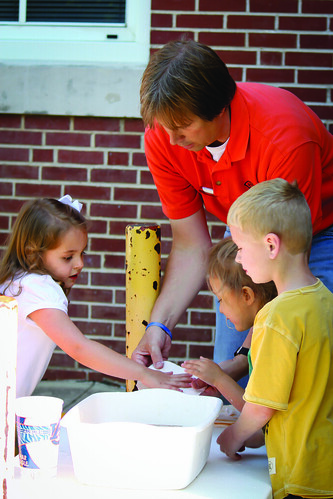Bill Josephson, chemical engineering lecturer, is using a mobile papermaking device designed and built in the department to teach local K-12 students how paper is made. He conducts several workshops a year for fourth-grade students at Wrights Mill Road elementary school in Auburn and 3- to 6-year-olds at the Children’s House, a local Montessori school.
“It’s not a typical science kit,” says Josephson. “It enables us to show the kids something in depth and realistic about how paper is made.”
The papermaking cart has two components. A cylinder with a screen base is attached to a fish tank used as a white water basin. A pump and series of pipes are used to fill the cylinder from the tank. Pulp fiber is then added to the cylinder and hand mixed, and a separate valve pumps the water back out. The fibers left on the screen are then pressed and dried.
The mobile device uses a similar lab technique that Josephson uses to teach Auburn Engineering students about pulp and paper engineering. Chemical engineering students in the pulp and paper program take a lab course in which they use the technique to make hundreds of paper hand sheets, or small-scale batches of paper, and conduct experiments on fiber quality and various types of fibers, additives and wet strengths.
The department’s mobile papermaking device has a long history. It was built by professor emeritus Gopal Krishnagopalan and former lab technician Joe Aderholt. Josephson remembers using the device as a graduate student, and still has hand sheets from his lab course during the ’90s.
[miniflickr photoset_id=72157631953097746&sortby=date-posted-asc&per_page=50]
